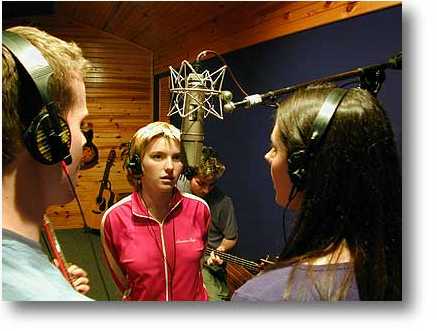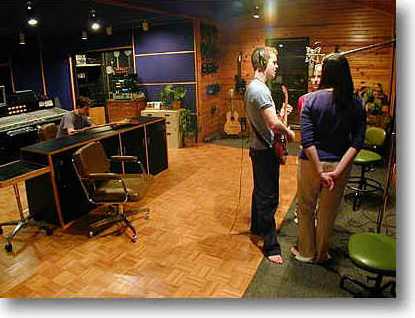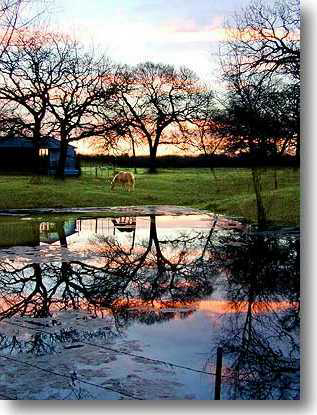How to prepare for Your Recording Session. RECORDING SESSION PLANNING.

"Each recording is unique, and requires careful recording session planning to guarantee the best sound quality and the most appropriate use of time and finances for your project. Here are some guidelines to help with your planning..."
Most of our projects at Back at the Ranch studio are a release quality recording. This is a product that will be similar in sound quality to a major-label record product, suitable for distribution, radio airplay and marketing to the public. Many times the product will be duplicated on CDs as well as made available as an streaming delivery download for Itunes, CD baby, and other virtual distribution. A CD product will usually be about 45 minutes in length, and include from 10 to 12 songs.
The studio recording process for a release quality music production normally involves.....
1. Basic tracks - The initial recording process in which the rhythm and chord instruments are recorded, usually with a "scratch" vocal. Time is spent setting up, maximizing the sound quality of each instrument, adjusting microphones, mike placement, preamps, etc., and finally getting the performance down to the satisfaction of the musicians and producer.
2. Overdubs - Additional components of the music are added to the basic tracks, (lead vocals, harmony vocals, percussion, strings, solo guitars, midi/keyboards, etc.)
3. Mixdown - When all the parts have been recorded, the mixdown process blends each sound with the others, massaging the sound into a composite stereo image.
4. Mastering - Preparing the final product for distribution and duplication. Mastering involves consideration of a collection's correct timing and sequence, balancing overall loudness and volumes, tone, and dynamics to maximize the sound quality for the targeted playback delivery and medium, and putting the final "spit and polish" on the master. This is the least understood part of the process, but can make the difference between a good product and a fantastic product. WHY MASTERING

Your music is unique. Back at the Ranch studio can help you with the individual attention and planning your project needs to guarantee a successful product.
So how much time and money should be budgeted for your recording project?
We will work with you to help you estimate the amount of time you will need to complete your recording project. We estimate the time needed based on the size of your group, number of instruments, songs and tracks, and the experience level of those being recorded.
Once in the studio, many times you may hear details in your performance that you have never paid attention to before, and decide to redo or add tracks that you had not originally planned on. Also, when you hear some of the incredible enhancements our studio can add to your project, you may decide to add more time to your session, and many clients decide to return another day to bring their project to the next level. So just to be safe, you may want to budget some extra funds in reserve so that you can have the option of adding additional tracks or enhancements to your project.
Here are some typical budgets for projects.....
For small acoustic ensembles, a release quality production of 10 songs can often be done live in the studio, and will usually require only basic tracks, a few overdubs, mixdown and mastering. This type of recording generally takes 6-10 production days, and may range in cost from $3500 to $6000 or more for a finished release quality master. Check out "AT HIS FEET", and "A PEARL IN YOU" on our Soundbites page for examples.
For a larger 4-10 member music group with drums and more instruments, a release quality production requires more complex basic tracks, many overdubs, more mixing, and mastering. This type of recording ranges from 10-24 production days, and generally ranges in cost from $5000 to $12000 or more for a finished master. Check out "ROCK OF MY SALVATION", and "WONDERFUL WORDS OF LIFE" on our Soundbites page for examples.
For a solo artist who bases their music on keyboard, piano, synth, or solo guitar accompaniment, a release-quality product can cost less because of the simplified arrangements and instrumentation. Usually solo artists can benefit from production help, including some additional instruments and midi/synth pads to orchestrate and fill out their sound. Check out Ruth Carter on our Soundbites page. A release quality CD length solo project usually ranges in cost from $3000 to $9,000.
You could spend less on a recording, or you could spend more, depending on the artist's preparation, requirements, and additional production and instrumentation desired.
Remember that a release quality production is one that:
-
Is suitable for radio airplay and marketing to the public
-
Will have the sound quality you expect from a commercially available product
-
You won't have to make excuses for
- You can continue to be proud of and market for years to come
When choosing a studio, be aware that a cheap hourly rate at a studio does not necessarily mean you are getting a good value (see our CHOOSING A STUDIO web page) . The reason that experienced artists and producers record in the better studios with the more experienced engineers, is that the recording quality is consistently better, the actual value is much higher, and you'll always get that major-label-sound and more bang for your buck!
Working in a better studio with a seasoned professional engineer costs more per hour, but you will always end up using less studio time while producing a professional product.

The Role of the Producer.....
At all sessions there is one person who has the final responsibility for the music and the production. It is the producer's job to oversee the recording project as a whole, including the creative direction and the business aspects.The right producer will greatly enhance the quality of your project because he functions as an objective partner. The producer's job includes ongoing evaluation of the recorded performances with respect to how they fit together to create the best, highest quality end product. With the "big picture" in mind at all times, the producer is able to take the project from the first run-through all the way to the final master. If you need some production guidance or help, Brian Konzelman's 50 years of major-label production experience is available.
Preparing for the sessions.....
Guitars and basses, bring your own instruments to the sessions. While Back at the Ranch has many instruments available, your own equipment is a part of your signature sound. If you are an electric guitar player be sure to bring your own guitar and amplifier to the session, and bring your favorite amp-modeling pre-amp or effects too. There is no guarantee that you will be able to get "your sound" on different equipment from what you normally use. Bass players generally do not need to bring their amp and speakers because they usually record direct through one of our many tube or solid-state pre-amps and direct boxes. Put new strings on your guitars one day before the session so they have a chance to stretch out. Make sure you tune guitars several times so that they get used to being at the correct pitch. Check your 12th fret notes vs. harmonics and adjust your bridges accordingly .
Keyboardists should bring their own keyboards and keyboard stand. Bring your owner's manual, power supply, pedals and cables. We have loads of midi gear and voice modules available if you wish to use them, but your own sounds will be much faster to setup and record.
Drummers need to bring their own sets. Remember that microphones will be very close to each drum and the smallest rattles and buzzes can ruin a take. Make sure the heads are reasonably new, and the pedals do not squeak. While we can mike your kit in twenty minutes and have it sounding pretty good, be aware that most release quality recordings take from 1 to three hours of fine tuning the drum setup for optimal sound on an album project. This extra time is always a good investment into your overall project, and can bring your overall sound to a much higher level.
Vocalists, know your vocals. People singing background vocals that do not sing any lead vocals, must rehearse the pronunciation and intonation closely with the lead vocalist. What sounds perfectly acceptable live can sound pretty ragged when exposed to the intense scrutiny of the recording studio. Rehearse group entrances and the cutoffs at the end of long held notes. The lead vocalist should direct the cutoffs, with the other singers watching the leader's lips.
Don't bring friends to the session who are not directly involved with the project. They will take your attention away from the recording, and cost you quality and dollars.
Know your music completely. The more prepared you are, the better your recording will be. The studio is not a rehearsal hall. Nail your performances. The best sounding recordings are generally the best prepared. Do your rehearsing at home. If you have a home studio of any type, record your entire project on your boom box or 4-track at home. Doing this will reveal unforeseen problems and will provide a good reference for the engineer to hear your direction when you get to the session.

Remember, recording should be fun. Relax and enjoy your Back at the Ranch recording experience. Take some pictures. Take a break often, and go for a walk on our beautiful wooded property to clear your ears.
(Picture taken early one morning at our gate)

For some good ideas on how to raise funds for your recording, and to find out how your recording can be used as a fundraiser, see our YOUR RECORDING AS A FUNDRAISER web page.
For more information on Back at the Ranch rates and services, see our RATES AND SERVICES web page.
Visit these links to other pages at RanchStudio.com.....
- HomePage
- Recording Studio Virtual Tour
- Meet Brian
- Mastering
- Rates and services
- Soundbites
- Helpful Links
- Students
- Audio Technology Studies, Recording Studio School info
- Christian Recording Studio
- Contact us
Articles
Share this info with your friends! click on one of the social network icons below.....
